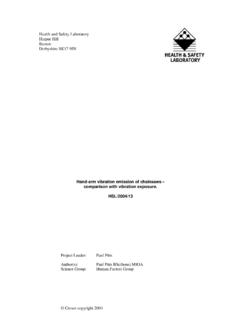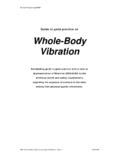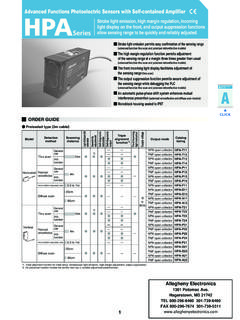Transcription of Correlation between vibration emission and …
1 Health and Safety Executive Correlation between vibration emission and vibration during real use Nibblers and shears Prepared by the Health and Safety Laboratory for the Health and Safety Executive 2007. RR576. Research Report Health and Safety Executive Correlation between vibration emission and vibration during real use Nibblers and shears Emma Shanks BSc MIOA Health and Safety Laboratory Harpur Hill Buxton SK17 9JN. The aims of the work reported here were: To assess the BS EN ISO 8662 10 (pneumatic tools) and the BS EN 60745 2 8 (electric tools) emission test for usability and repeatability.
2 To assess reproducibility by comparing our results with manufacturers' declared vibration emission values (and verifying in accordance with BS EN 12096). To compare vibration emission values with vibration magnitudes measured under real operating conditions. To assess vibration emission data as an indicator of vibration hazard. This report and the work it describes were funded by the Health and Safety Executive (HSE). Its contents, including any opinions and/or conclusions expressed, are those of the author alone and do not necessarily reflect HSE policy.
3 HSE Books Crown copyright 2007. First published 2007. All rights reserved. No part of this publication may be reproduced, stored in a retrieval system, or transmitted in any form or by any means (electronic, mechanical, photocopying, recording or otherwise) without the prior written permission of the copyright owner. Applications for reproduction should be made in writing to: Licensing Division, Her Majesty's Stationery Office, St Clements House, 2 16 Colegate, Norwich NR3 1BQ. or by e mail to hmsolicensing@cabinet Acknowledgements The author gratefully acknowledges those who assisted in this project, in particular the tool manufacturers who supplied the tools and the sites that were visited to obtain field vibration data.
4 Ii CONTENTS. 1 1. Declaration of vibration emission .. 1. Outline of 2. Terminology for emission 2. 2 TOOLS 3. 3 LABORATORY TESTING OF vibration emission .. 4. emission test 4. emission test procedure .. 4. Data acquisition and analysis .. 7. emission test 8. 4 ADDITIONAL LABORATORY MEASUREMENTS .. 10. BS EN 60745-2-8:2003 vs EN 60745-2-8/prAA April 10. Left hand tool operation vs right hand tool operation .. 14. Tool C's auxiliary 15. Influence of distance of cut from edge of test bench .. 16. 5 FIELD / SIMULATED REAL MEASUREMENTS.
5 19. The 19. What actually happened .. 19. Data acquisition and analysis .. 21. Field / simulated real results .. 21. 6 23. Analysis of emission data .. 23. Field / simulated real measurements .. 29. emission values as an indicator of risk .. 34. Tool 35. 7 37. 8 38. iii iv EXECUTIVE SUMMARY. Objectives The aims of the work reported here were: To assess the BS EN ISO 8662-10 (pneumatic tools) and the BS EN 60745-2-8 (electric tools) emission test for usability and repeatability To assess reproducibility by comparing our results with manufacturers' declared vibration emission values (and verifying in accordance with BS EN 12096).
6 To compare vibration emission values with vibration magnitudes measured under real operating conditions To assess vibration emission data as an indicator of vibration hazard. Main Findings 1. Manufacturer's declared emission values as measured according to BS EN ISO 8662- 10:1998 and BS EN 50144-2-8:1996 (predecessor to BS EN 60745-2-8) were verified according to the criteria in BS EN 12096:1997 in 4 out of 7 cases; 2 out of 7 cases were not verifiable. The remaining case was partially verified dependent on the test material and direction of operation.
7 2. The current standard test methods do not specify one particular test material or a range of test materials. It is therefore unclear to what type of material the manufacturer's declared emissions relate. This research has shown that for one tool cutting three different types of material, the total vibration value can vary by up to 30ms-2. 3. Based on the data in this study, single axis a emission values may be lower than the total triaxial a emission values by up to 4. There is great potential for vibration levels to vary between materials, operators, tools and a combination of all three factors.
8 Operator skill and experience also play a role. 5. The amount of material to cut off for the purpose of a repeatable and reproducible laboratory test is undetermined due to the amount of variation possible. Varying the width of material to cut off introduces another variable into an already complex situation. The specifications in EN 60745-2-8/prAA will help. 6. For electric tools, the triaxial transducer locations on top of the tool in EN 60745-2-8/prAA. will yield a higher vibration value than the current standard test (single axis underneath the tool).
9 For pneumatic tools, BS EN ISO 8662-10 (transducers located underneath the tool). triaxial measurement will yield a higher vibration value than the current single axis requirement. 7. Transducer location influences vibration magnitudes. For electric tools, EN 60745-2- 8/prAA overestimates the mean in-use values (transducers on top). For pneumatic tools, BS EN ISO 8662-10 underestimates the mean in-use values (transducers underneath). End users of the tools are at risk of not being in possession of data representative of vibration hazard.
10 8. It was not possible to investigate in-use values in terms of emission upper quartile data due to a lack of field sites. 9. The current test methods do not take the efficiency of the tool into account. vibration data should not be used in isolation to identify the best tool for a particular application. v Consideration must also be given to the rate of work achieved and suitability for the application. 10. Tools with plastic handles, whether the main handle or an auxiliary handle, can resonate which influences measured vibration data.















